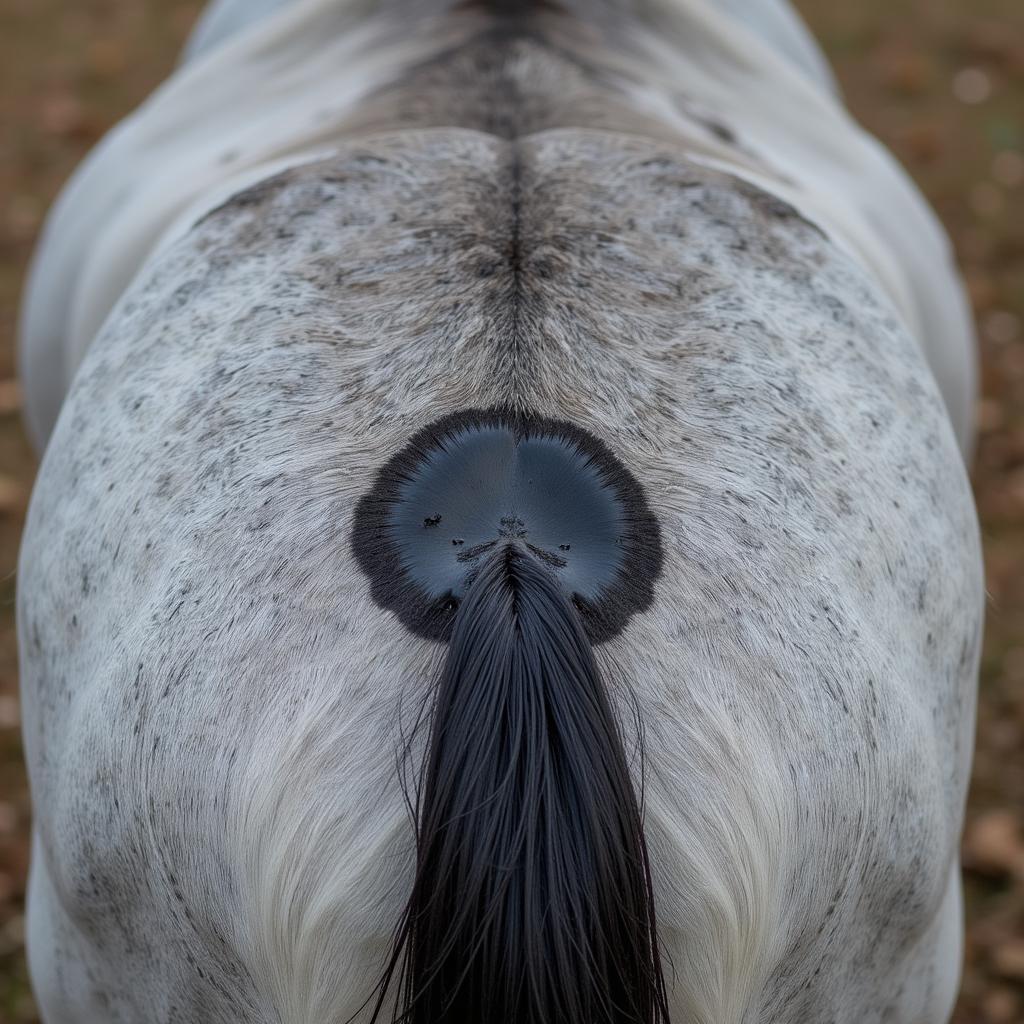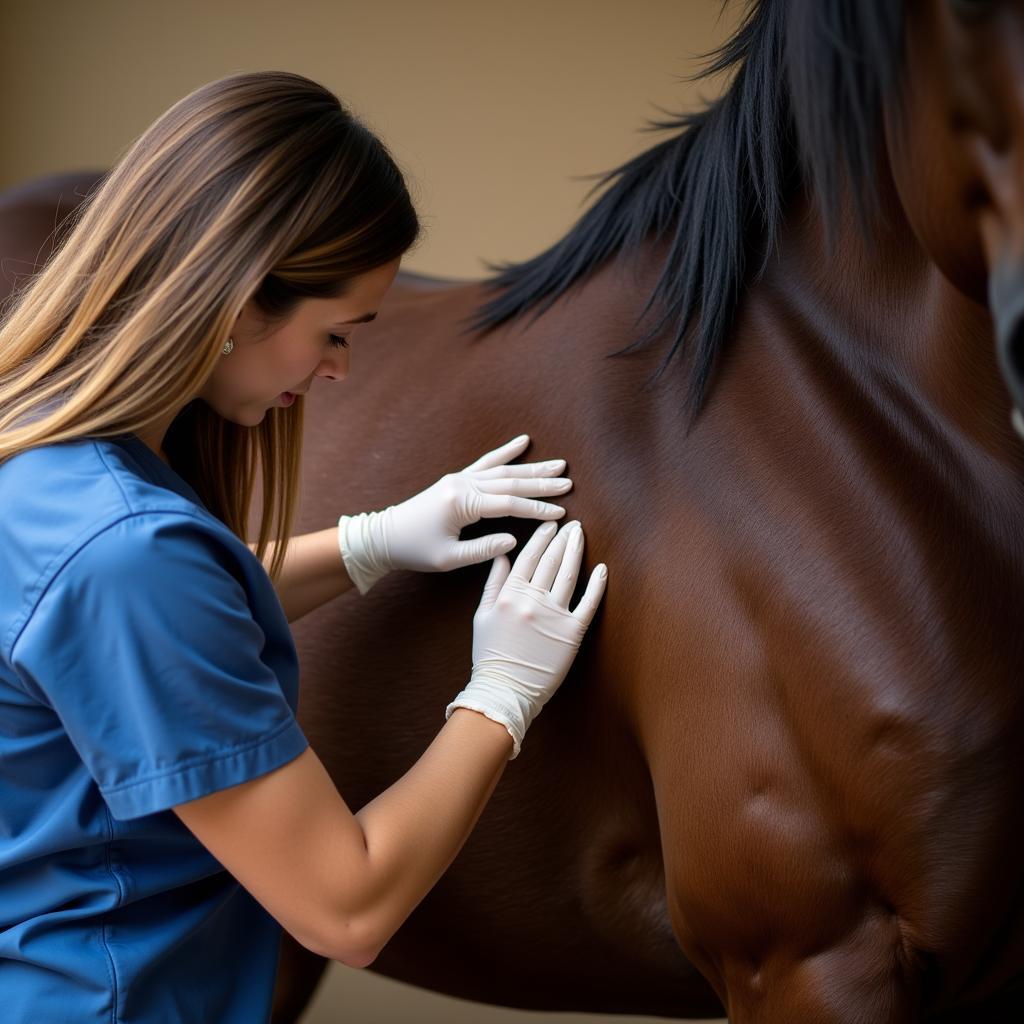A lump on your horse’s spine can be alarming. This article will explore the potential causes of lumps on a horse’s spine, ranging from benign cysts to more serious conditions. We’ll cover diagnosis, treatment options, and when to call the vet, equipping you with the knowledge to ensure your equine companion receives the best possible care.
Understanding Lumps on a Horse’s Spine
Lumps on a horse’s spine can vary in size, shape, and texture. They can be hard or soft, mobile or fixed, and may or may not be painful to the touch. Identifying the characteristics of the lump is crucial for diagnosis. Several factors can contribute to the development of lumps on a horse’s spine, including trauma, infection, and even insect bites.
Common Causes of Lumps on a Horse’s Spine
- Melanoma: This type of skin cancer is relatively common in gray horses and can appear as raised, pigmented lumps.
- Sarcoids: These are the most common skin tumors in horses and can manifest in various forms, including nodular, verrucous, and fibroblastic. They can occur anywhere on the body, including the spine.
- Warts: Caused by the equine papillomavirus, warts are usually benign and often regress spontaneously.
- Cysts: These fluid-filled sacs can develop under the skin and are generally harmless.
- Abscesses: A localized collection of pus, often due to bacterial infection, can form a lump on the spine.
- Hematoma: A localized collection of blood outside of blood vessels, often caused by trauma.
- Fistulous Withers/Poll Evil: While not directly on the spine, these infections can sometimes track along the ligaments and appear as lumps near the withers or poll.
 Melanoma on Horse's Spine
Melanoma on Horse's Spine
Diagnosing a Lump on Your Horse’s Spine
If you discover a lump on your horse’s spine, it’s essential to consult with a veterinarian. They will perform a thorough physical examination and may recommend further diagnostic tests, such as:
- Fine-needle aspiration: A small needle is inserted into the lump to collect cells for microscopic examination.
- Biopsy: A small tissue sample is removed from the lump for laboratory analysis.
- Blood tests: These can help identify underlying infections or other systemic issues.
- Imaging techniques: X-rays, ultrasound, or CT scans may be necessary to evaluate the extent of the lump and its involvement with surrounding tissues.
 Veterinarian Examining a Lump on a Horse's Spine
Veterinarian Examining a Lump on a Horse's Spine
Treatment Options for Lumps on a Horse’s Spine
The treatment for a lump on a horse’s spine depends on the underlying cause. Options may include:
- Surgical removal: This is often the preferred treatment for tumors, cysts, and abscesses.
- Medication: Antibiotics may be prescribed for bacterial infections, while anti-inflammatory drugs can help reduce pain and swelling.
- Cryotherapy: Freezing the lump with liquid nitrogen can be effective for treating warts and some types of tumors.
- Topical treatments: Certain creams or ointments may be used to treat localized infections or skin conditions.
- Other therapies: Depending on the diagnosis, other therapies like immunotherapy or radiation therapy may be considered.
When to Call the Vet
Any new lump or growth on your horse’s spine warrants veterinary attention. Early diagnosis and treatment are crucial, especially for cancerous tumors.
- Sudden appearance: A lump that appears suddenly or grows rapidly should be evaluated immediately.
- Pain or discomfort: If the lump is painful or causing your horse discomfort, seek veterinary advice.
- Changes in size, shape, or color: Monitor the lump for any changes and report them to your veterinarian.
- Discharge or bleeding: Any discharge or bleeding from the lump requires immediate veterinary attention.
Conclusion
Discovering a lump on your horse’s spine can be concerning. Understanding the potential causes, diagnostic procedures, and treatment options empowers you to take proactive steps in ensuring your horse’s well-being. Always consult with a veterinarian for any new lump or growth on your horse’s spine for accurate diagnosis and appropriate treatment.
FAQ
- What is the most common cause of a lump on a horse’s spine? Sarcoids are the most common skin tumors in horses and can appear on the spine.
- Are all lumps on a horse’s spine cancerous? No, many lumps are benign, such as cysts, warts, or hematomas.
- Can a lump on a horse’s spine be caused by an injury? Yes, trauma can lead to hematomas or abscesses.
- How is a lump on a horse’s spine diagnosed? Veterinarians use methods like fine-needle aspiration, biopsy, and imaging techniques.
- What are the treatment options for a lump on a horse’s spine? Treatment depends on the cause and may include surgery, medication, cryotherapy, or topical treatments.
- When should I call the vet about a lump on my horse’s spine? Any new lump, especially one that grows quickly, is painful, or changes in appearance, requires veterinary attention.
- Can lumps on a horse’s spine be prevented? Not all lumps can be prevented, but regular grooming and inspections can help with early detection.
For any concerns about your horse’s health, please contact us at Phone Number: 0772127271, Email: [email protected] Or visit us at: QGM2+WX2, Vị Trung, Vị Thuỷ, Hậu Giang, Việt Nam. We have a 24/7 customer service team.